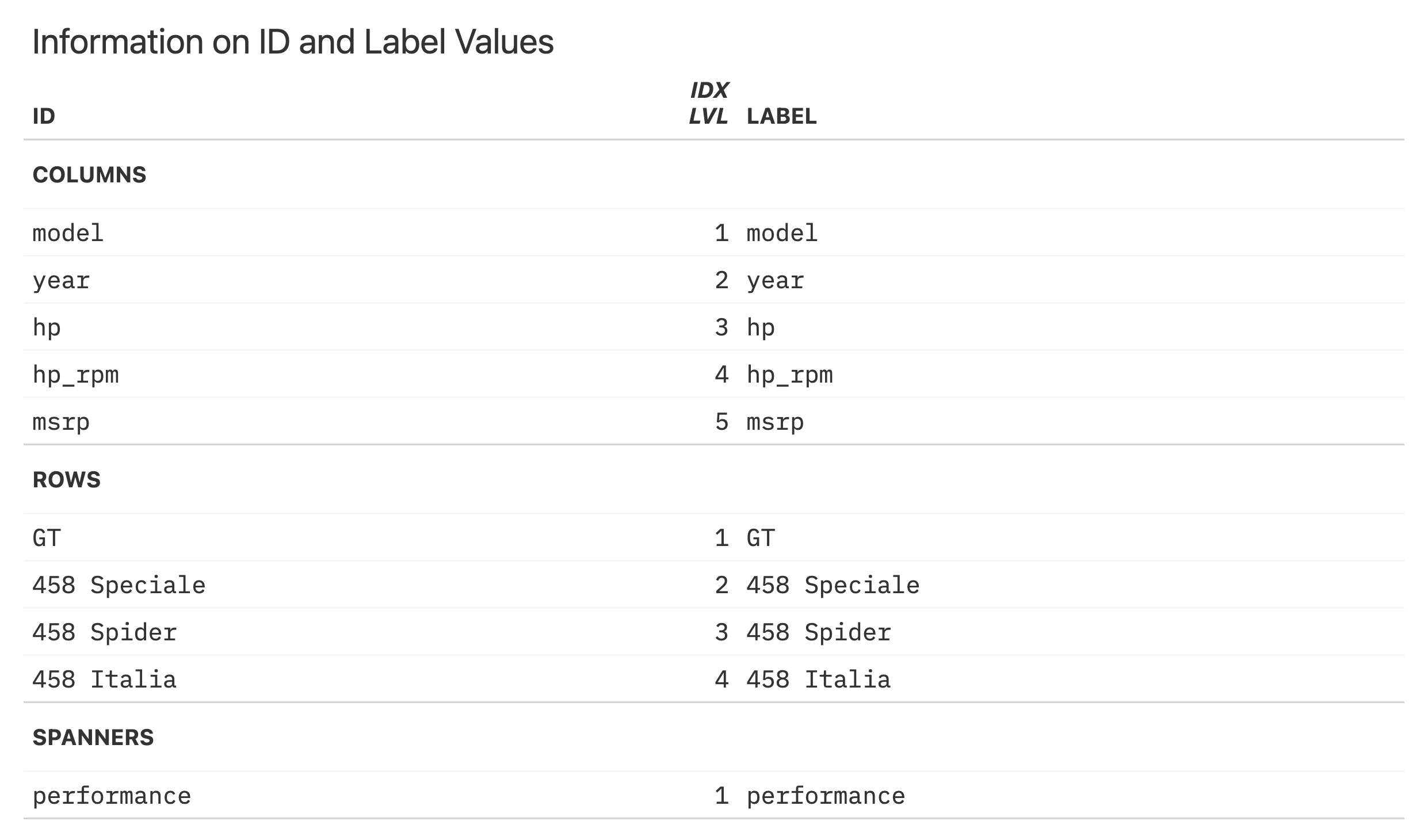tab_info: Understand what's been set inside of a *gt* table object
In rstudio/gt: Easily Create Presentation-Ready Display Tables
tab_info R Documentation
Understand what's been set inside of a gt table object
Description
It can become increasingly difficult to recall the ID values associated with
different labels in a gt table. Further to this, there are also
situations where gt will generate ID values on your behalf (e.g., with
tab_spanner_delim(), etc.) while ensuring that duplicate ID values aren't
produced. For the latter case, it is impossible to know what those ID values
are unless one were to carefully examine to correct component of the gt_tbl
object.
Because it's so essential to know these ID values for targeting purposes
(when styling with tab_style(), adding footnote marks with
tab_footnote(), etc.), tab_info() can help with all of this. It
summarizes (by location) all of the table's ID values and their associated
labels. The product is an informational gt table, designed for easy
retrieval of the necessary values.
Usage
tab_info(data)
Arguments
data
The gt table data object
obj:<gt_tbl> // required
This is the gt table object that is commonly created through use of the
gt() function.
Value
An object of class gt_tbl.
Examples
Let's use a portion of the gtcars dataset to create a gt table. We'll
use tab_spanner() to group two columns together under a spanner column with
the ID and label "performance". Finally, we can usetab_info() in a
separate, interactive statement so that we can inspect a table that
summarizes the ID values any associated label text for all parts of the
table.
gt_tbl <-
gtcars |>
dplyr::select(model, year, starts_with("hp"), msrp) |>
dplyr::slice(1:4) |>
gt(rowname_col = "model") |>
tab_spanner(
label = "performance",
columns = starts_with("hp")
)
gt_tbl |> tab_info()

Function ID
2-12
Function Introduced
v0.8.0 (November 16, 2022)
See Also
Other part creation/modification functions:
tab_caption(),
tab_footnote(),
tab_header(),
tab_options(),
tab_row_group(),
tab_source_note(),
tab_spanner(),
tab_spanner_delim(),
tab_stub_indent(),
tab_stubhead(),
tab_style(),
tab_style_body()
rstudio/gt documentation built on March 29, 2025, 4:02 a.m.
| tab_info | R Documentation |
Understand what's been set inside of a gt table object
Description
It can become increasingly difficult to recall the ID values associated with
different labels in a gt table. Further to this, there are also
situations where gt will generate ID values on your behalf (e.g., with
tab_spanner_delim(), etc.) while ensuring that duplicate ID values aren't
produced. For the latter case, it is impossible to know what those ID values
are unless one were to carefully examine to correct component of the gt_tbl
object.
Because it's so essential to know these ID values for targeting purposes
(when styling with tab_style(), adding footnote marks with
tab_footnote(), etc.), tab_info() can help with all of this. It
summarizes (by location) all of the table's ID values and their associated
labels. The product is an informational gt table, designed for easy
retrieval of the necessary values.
Usage
tab_info(data)
Arguments
data |
The gt table data object
This is the gt table object that is commonly created through use of the
|
Value
An object of class gt_tbl.
Examples
Let's use a portion of the gtcars dataset to create a gt table. We'll
use tab_spanner() to group two columns together under a spanner column with
the ID and label "performance". Finally, we can usetab_info() in a
separate, interactive statement so that we can inspect a table that
summarizes the ID values any associated label text for all parts of the
table.
gt_tbl <-
gtcars |>
dplyr::select(model, year, starts_with("hp"), msrp) |>
dplyr::slice(1:4) |>
gt(rowname_col = "model") |>
tab_spanner(
label = "performance",
columns = starts_with("hp")
)
gt_tbl |> tab_info()

Function ID
2-12
Function Introduced
v0.8.0 (November 16, 2022)
See Also
Other part creation/modification functions:
tab_caption(),
tab_footnote(),
tab_header(),
tab_options(),
tab_row_group(),
tab_source_note(),
tab_spanner(),
tab_spanner_delim(),
tab_stub_indent(),
tab_stubhead(),
tab_style(),
tab_style_body()
Add the following code to your website.
For more information on customizing the embed code, read Embedding Snippets.
